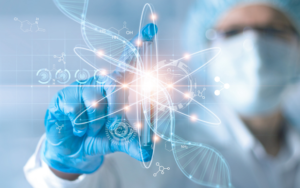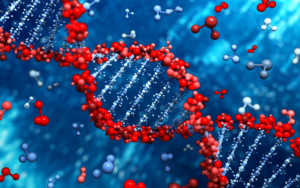Transcription is a fundamental process that lies at the heart of gene expression in all living organisms. In prokaryotes, such as bacteria and archaea, transcription plays a pivotal role in converting genetic information stored in DNA into functional RNA molecules. This essential process governs the synthesis of proteins and non-coding RNAs, impacting the entire life cycle of prokaryotic organisms. In this comprehensive blog post, we will explore the intricate world of transcription in prokaryotes, shedding light on the key mechanisms and processes that drive this vital aspect of molecular biology.
Table of Contents
Understanding Transcription in Prokaryotes
Prokaryotic Gene Structure
Prokaryotic gene structure serves as the foundation for the intricate process of transcription in prokaryotes. These simple organisms, such as bacteria and archaea, possess a single, circular DNA molecule located within the nucleoid region of the cell. Genes in prokaryotes consist of open reading frames (ORFs) that encode for proteins or non-coding RNAs, essential for various cellular functions. Transcription is initiated at specific sites known as promoters, and the process is carried out by RNA polymerase, an enzyme with multiple subunits, including the core enzyme and sigma (σ) factor. The sigma factor plays a crucial role in recognizing and binding to promoters, ensuring the accurate initiation of transcription. As RNA polymerase advances along the DNA template, it synthesizes a complementary RNA strand in the 5′ to 3′ direction, leading to the formation of essential RNA molecules. Understanding the prokaryotic gene structure and the transcription process sheds light on the fundamentals of gene expression, impacting the entire life cycle and adaptability of these remarkable organisms.
RNA Polymerase
The enzyme responsible for transcription in prokaryotes is RNA polymerase. This complex molecular machine carries out the synthesis of RNA using the DNA template. Prokaryotes have a single RNA polymerase with multiple subunits, including the core enzyme (composed of α2ββ’ω subunits) and a sigma (σ) factor, which is required for promoter recognition.
structure of RNA polymerase in prokaryotes
The structure of RNA polymerase in prokaryotes is a fascinating and intricate molecular machinery essential for gene expression. Prokaryotic RNA polymerase is a multisubunit enzyme comprising a core enzyme and a sigma (σ) factor. The core enzyme consists of five subunits – two α subunits, one β subunit, one β’ subunit, and one ω subunit – which collectively form the catalytic center. The sigma factor plays a crucial role in promoter recognition, guiding the RNA polymerase to specific DNA promoter regions to initiate transcription. Once bound to the promoter, RNA polymerase unwinds a small segment of the DNA, exposing the template strand for complementary RNA synthesis. This highly regulated enzyme ensures accurate and efficient transcription of genes in prokaryotes, making it a fundamental component of cellular processes.
Phases of Transcription in Prokaryotes
Transcription is a critical process in prokaryotes that converts the genetic information stored in DNA into functional RNA molecules. This molecular mechanism occurs in three distinct phases: initiation, elongation, and termination. Understanding these phases sheds light on the intricate regulatory mechanisms that drive gene expression in prokaryotic organisms.
Initiation
In the initiation phase of transcription in prokaryotes, RNA polymerase, the enzyme responsible for RNA synthesis, binds to the promoter region on the DNA. The RNA polymerase holoenzyme, comprising the core enzyme and a sigma factor, recognizes specific DNA sequences in the promoter region. The sigma factor plays a pivotal role in promoter recognition, guiding the RNA polymerase to the correct start site for transcription.
Once bound to the promoter, the RNA polymerase unwinds a small section of the DNA double helix, exposing the template strand. This unwinding allows the RNA polymerase to initiate the synthesis of a complementary RNA strand based on the DNA template. The initiation phase is crucial as it determines which genes are actively transcribed and serves as a primary point of regulation for gene expression in prokaryotes.
Elongation
During the elongation phase of transcription, the RNA polymerase moves along the template DNA, synthesizing a complementary RNA molecule. As the enzyme advances, it adds ribonucleotides to the growing RNA chain in a 5′ to 3′ direction. The elongation process continues until the RNA polymerase reaches the terminator sequence or a termination signal.
The elongation phase is a complex and highly regulated process, ensuring the accurate and efficient synthesis of RNA transcripts. Factors such as transcriptional elongation factors and nucleotide availability influence the rate of elongation and can impact the overall gene expression profile in prokaryotes.
Termination
Transcription termination in prokaryotes can occur via two main mechanisms: Rho-independent termination and Rho-dependent termination.
Rho-Independent Termination
In Rho-independent termination, specific DNA sequences in the terminator region cause the newly synthesized RNA transcript to fold into a stable hairpin structure, followed by a stretch of uracil-rich (U) nucleotides. This hairpin-U structure destabilizes the RNA-DNA hybrid, leading to the detachment of the RNA transcript from the DNA template and the release of the RNA polymerase.
Rho-Dependent Termination
Rho-dependent termination involves the Rho protein, which recognizes specific termination signals on the RNA transcript. The Rho protein tracks along the RNA strand, catching up to the RNA polymerase. It then interacts with the enzyme, causing the detachment of the RNA transcript from the DNA template and terminating transcription.
The termination phase is crucial for accurate gene expression, preventing the synthesis of aberrant RNA transcripts and facilitating the recycling of RNA polymerase for subsequent rounds of transcription.
Regulation of Transcription in Prokaryotes
Transcription in prokaryotes is a highly regulated process that allows these simple organisms to adapt and thrive in various environments. The regulation of transcription is essential to control gene expression, ensuring that specific genes are transcribed at the right time and in response to various stimuli. Understanding the mechanisms of transcriptional regulation in prokaryotes provides invaluable insights into their survival strategies and offers potential applications in biotechnology and medicine.
Transcription Factors and Promoter Recognition
Transcription factors play a critical role in regulating prokaryotic gene expression. These proteins bind to specific DNA sequences near the promoter region, either enhancing or inhibiting RNA polymerase binding. Activator proteins promote transcription by facilitating the recruitment of RNA polymerase to the promoter, while repressor proteins hinder transcription initiation by blocking RNA polymerase access. The interplay between transcription factors ensures precise control of gene expression in response to environmental cues.
Operons: Coordinated Gene Expression
Prokaryotic genes are often organized into operons, which are clusters of functionally related genes transcribed as a single mRNA molecule. This arrangement enables coordinated regulation of multiple genes involved in the same metabolic pathway. The operon structure allows prokaryotes to optimize their resources by simultaneously activating or repressing an entire set of genes to meet specific cellular demands.
Sigma Factors and Promoter Specificity
RNA polymerase in prokaryotes requires sigma factors to recognize and bind to specific promoter sequences on the DNA. Different sigma factors confer promoter specificity, allowing RNA polymerase to initiate transcription at the appropriate genes under diverse conditions. By altering the sigma factor associated with RNA polymerase, prokaryotes can respond rapidly to environmental changes, adjusting their gene expression patterns accordingly.
Feedback Loops and Fine-Tuning
Transcriptional regulation in prokaryotes often involves feedback loops that fine-tune gene expression. Regulatory proteins, such as repressors, can be influenced by the end products of certain metabolic pathways. If the concentration of a product exceeds the cellular needs, it may bind to the repressor, preventing its interaction with the DNA and thus allowing transcription of the relevant genes to decrease. This feedback mechanism helps maintain cellular homeostasis and avoid unnecessary energy expenditure.
Environmental Sensing and Transcriptional Responses
Prokaryotes excel at sensing and responding to environmental changes. When exposed to stressors like temperature fluctuations or nutrient availability, specific transcription factors sense these signals and activate or repress genes associated with stress response pathways. For instance, bacteria can mount an immediate transcriptional response to combat harmful substances or adapt to new growth conditions, ensuring their survival in challenging environments.
Overall, understanding the process of transcription in prokaryotes is crucial for unraveling the intricacies of gene expression in these simple yet remarkable organisms. Through this comprehensive exploration, we’ve delved into the key mechanisms that drive transcription in prokaryotes, shedding light on its significance in protein synthesis, adaptation, and survival. The role of RNA polymerase, along with the influence of transcription factors and operons, orchestrates the precise regulation of gene expression in response to varying environmental cues.
Transcription serves as the pivotal gateway to the synthesis of proteins and non-coding RNAs, shaping the entire life cycle of prokaryotic organisms. From initiation to elongation and termination, each step is precisely orchestrated, ensuring that the right genes are transcribed at the right time and in the right amounts. The tightly controlled transcriptional regulation allows prokaryotes to adapt rapidly to changing environments, enabling their survival and evolution over millions of years.
As research and technology continue to advance, the study of transcription in prokaryotes holds promising potential for diverse fields. Biotechnologists can harness this knowledge to engineer novel genetic circuits and optimize gene expression in various applications, from biopharmaceutical production to environmental bioremediation. Moreover, a deeper understanding of transcription in prokaryotes may offer insights into human diseases, as many fundamental cellular processes are conserved between prokaryotes and eukaryotes.




